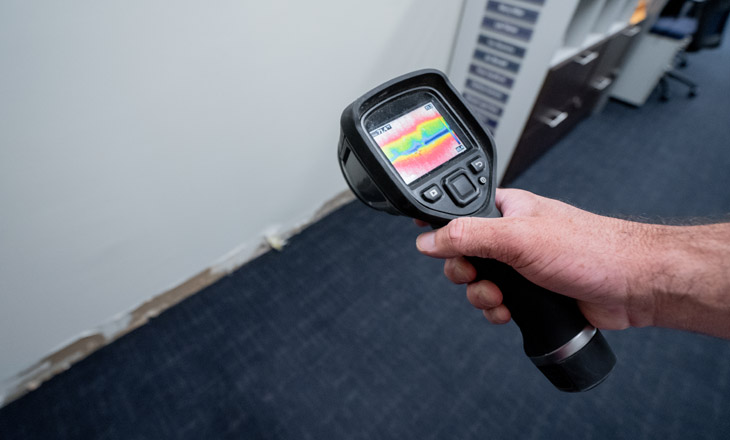Comprehensive Guide to Water Leak Detection for Home Owners and Businesses
Comprehensive Guide to Water Leak Detection for Home Owners and Businesses
Blog Article
Innovative Solutions for Early Detection of Water Leakages in Structures and Framework
As the stability of structures and facilities is paramount, the obstacle of very early discovery of water leaks has stimulated cutting-edge options that guarantee to reinvent the means we guard against possible damages. From sophisticated leak discovery innovations to the release of IoT sensors for real-time surveillance, the landscape of leak avoidance is advancing swiftly. Artificial intelligence algorithms supply a look into the future of leakage forecast, while thermal imaging provides a non-intrusive method for identifying surprise leakages. Automated water circulation analysis systems are improving how leaks are recognized and attended to, paving the way for a proactive strategy to water leakage discovery. Each of these solutions holds the essential to making certain the reliability and longevity of our built setting, prompting a change towards an extra lasting and reliable future.
Advanced Leak Discovery Technologies
Advanced leakage detection modern technologies, furnished with sophisticated sensing units and algorithms, play an essential function in promptly identifying and pinpointing water leakages in numerous settings. These technologies use a mix of acoustic, thermal, and electromagnetic noticing methods to discover leakages properly. Acoustic sensing units spot the sound of leaving water, allowing for specific localization of the leak resource. Thermal imaging discovers temperature level changes created by water leakage, offering one more effective method for leakage recognition. Electromagnetic sensors can determine adjustments in electro-magnetic fields triggered by water, supplying yet one more layer of leak detection capacity.

IoT Sensors for Real-Time Surveillance
In the world of modern-day water leak detection, the assimilation of IoT sensors for real-time monitoring stands for a crucial improvement in boosting aggressive leak discovery abilities. These sensing units supply constant tracking of water systems, giving real-time data on water circulation rates, stress variants, and temperature changes. By leveraging IoT technology, these sensors can discover even the tiniest abnormalities in water use patterns, allowing very early identification of possible leakages before they rise into significant problems.
IoT sensors send information to a central platform, where sophisticated algorithms analyze the details and create alerts or alerts when abnormalities are found. This real-time monitoring capacity enables homeowner or facility supervisors to without delay address leaks, lessening water damages, lowering repair work expenses, and saving water sources.
Additionally, IoT sensing units can be integrated with structure management systems, permitting automatic actions to discovered leakages, such as turning off water shutoffs or turning on pumps to mitigate the effect of leakages. On the whole, the execution of IoT see here sensing units for real-time tracking dramatically improves the performance and effectiveness of water leakage detection in buildings and framework.
Artificial Intelligence Algorithms for Leakage Prediction

One secret benefit of utilizing artificial intelligence for leakage prediction is its capability to continuously discover and enhance its accuracy gradually. As more information is collected and fed right into the formula, it can improve its predictions and adjust to altering problems, eventually enhancing the reliability of leakage detection systems.
Moreover, machine learning algorithms can assist in determining subtle indications of leaks that might go unnoticed by traditional tracking approaches. water leak detection. By assessing complicated information sets in real-time, these algorithms can supply early cautions and informs, permitting punctual treatment and preventive maintenance why not look here to mitigate prospective water damage and connected prices
Utilizing Thermal Imaging for Leakage Detection
Thermal imaging technology supplies an encouraging method for spotting water leaks in various systems and frameworks. By using infrared radiation and temperature level variances, thermal imaging cameras can determine hidden leakages that are not quickly noticeable to the nude eye.
One of the key advantages of thermal imaging for leak discovery is its non-intrusive nature. In general, the usage of thermal imaging technology boosts the effectiveness and precision of water leak discovery, making it a useful tool for preserving the integrity of buildings and facilities.
Automated Water Flow Analysis Equipments
How can automatic water flow evaluation systems change the discovery and monitoring of leakages in various systems and infrastructures? Automated water flow evaluation systems provide a positive strategy to leak detection by continuously keeping an eye on water flow rates and patterns. By establishing baseline information, these systems can promptly recognize discrepancies that may indicate a leak, enabling timely treatment to stop considerable damage.
These systems use innovative algorithms to evaluate real-time information and give immediate informs when abnormalities are spotted, enabling for swift action to be taken. Furthermore, computerized water circulation analysis systems can be integrated with building management systems or IoT platforms, improving total efficiency and enabling remote monitoring abilities.
Moreover, the information gathered by these systems can be utilized for predictive upkeep objectives, helping to determine prospective powerlessness in the facilities before leaks take place. On the whole, the execution of automatic water flow analysis systems can significantly improve leakage discovery and administration practices, inevitably bring about set you back savings, lowered water wastefulness, and boosted sustainability in buildings and framework.

Verdict
In conclusion, the integration of sophisticated leakage discovery modern technologies, IoT sensing units, artificial intelligence formulas, thermal imaging, and computerized water go now circulation evaluation systems provides ingenious options for early detection of water leaks in buildings and framework. These modern technologies make it possible for real-time surveillance, prediction of leaks, and effective discovery approaches to stop water damages and wastefulness. Implementing these remedies can help in preserving the integrity and sustainability of water systems in numerous setups.
Report this page